Information Gathering Activities by the SDF in the Middle East

In response to the rising tensions in the Middle East, the Cabinet adopted a decision on December 27, 2019, which sets forth government-wide efforts to be promoted to ensure peace and stability and the safety of Japan-related vessels in the region. The Cabinet decision states that Japan will commence information gathering activities by the SDF as Japan’s independent initiative to strengthen its information gathering posture necessary to ensure the safety of Japan-related vessels. The government will carry out these activities as part of its navigation safety measures, while also making diplomatic efforts and thoroughly implementing other existing navigation safety measures.
In this page, we will answer some of the questions we often receive from the public about the SDF’s information gathering activities.
Note: Japan-related vessels include the following:
Japanese-flag ships
Foreign-flag ships that Japanese nationals are on board
Foreign-flag ships operated by Japanese shipping business operators
Foreign-flag ships transporting Japanese cargoes that are important for stable economic activities of Japanese people
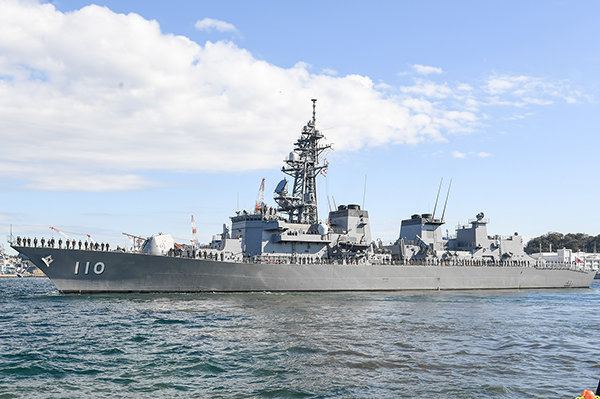
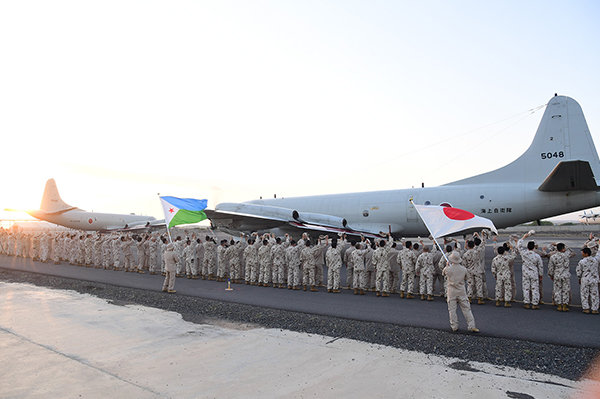
[ Outline of the Cabinet Decision]
Japan has decided to make efforts with regard to the following points as Japan’s independent initiative to ensure peace and stability in the Middle East and the safety of Japan-related vessels:
(1) further diplomatic efforts to ease tensions in the Middle East and stabilize the situation
(2) thorough implementation of navigational safety measures, including close information sharing with relevant industries; and
(3) better utilization of the SDF’s ships and aircraft to strengthen information gathering posture. The relevant ministries and agencies will work together to make government-wide efforts and implement comprehensive measures.
Below is a summary of the SDF’s information gathering activities.
Equipment: one destroyer will be newly dispatched. In addition, the SDF will also use aircraft of the units in the Counter-Piracy Operations.
Geographical Scope of Activities: three waters of high seas: the Gulf of Oman, the northern Arabian Sea, and the Gulf of Aden to the east of the Bab el-Mandeb Strait (including the exclusive economic zones of the coastal states).
Responding to Unforeseen Circumstances or Other Changes in the Situation: the relevant ministries and agencies will work together to understand the situation, and strengthen the government’s response. If further measures by the SDF are deemed necessary, Maritime Security Operations will be ordered.
Cooperation with Other Countries: Although Japan does not participate in any specific framework and the SDF’s information gathering activities are to be conducted at its own initiative, Japan will communicate and cooperate with other countries as necessary.
Duration of the SDF’s Activities: The period is for one year from the date of the Cabinet decision. If the SDF’s activities are no longer deemed necessary, the SDF will terminate such activities at that point. If there is a noticeable change in the situation, the National Security Council will consider a response.
Report to the Diet: The Diet is to receive a report whenever a Cabinet decision or any changes to it is made and a report on the results of such activities upon termination.
FAQ on the SDF Deployment
Q1: Why is it necessary to deploy the SDF to the Middle East?
A: Peace and stability in the Middle East are crucial to the peace and prosperity of the international community, including Japan. In addition, it is very important to ensure the safety of Japan-related vessels in the Middle East, which is the world’s major energy source and on which Japan depends for about 90% of its crude oil imports.
In the Middle East, amidst rising tensions, there were incidents of attacks on ships. In June 2019, “Kokuka Courageous ,” a Japan-related vessel suffered damage. Under these circumstances, countries are strengthening efforts to ensure the safety of navigation in the region by utilizing ships and aircraft.
In this context, Japan has decided to make government-wide efforts and implement comprehensive measures with regard to the following points as Japan’s independent initiative to ensure peace and stability in the Middle East and the safety of Japan-related vessels: (1) further diplomatic efforts; (2) thorough implementation of navigation safety measures; and (3) better utilization of the SDF’s ships and aircraft to strengthen information gathering posture.
Regarding (3), although there is no immediate need to implement protective measures for Japan-related vessels in the Middle East, given the rising tensions in the region, it is necessary to strengthen the information gathering system to ensure the safety of Japan-related vessels.
As mentioned above, countries are strengthening efforts to ensure the safety of navigation in the region by utilizing ships and aircraft. In this context, Japan has decided to have the SDF conduct information gathering activities, considering the distance from Japan to the Middle East region, the SDF’s experience in operating in the region, and the importance of cooperation with units and organizations from other countries.
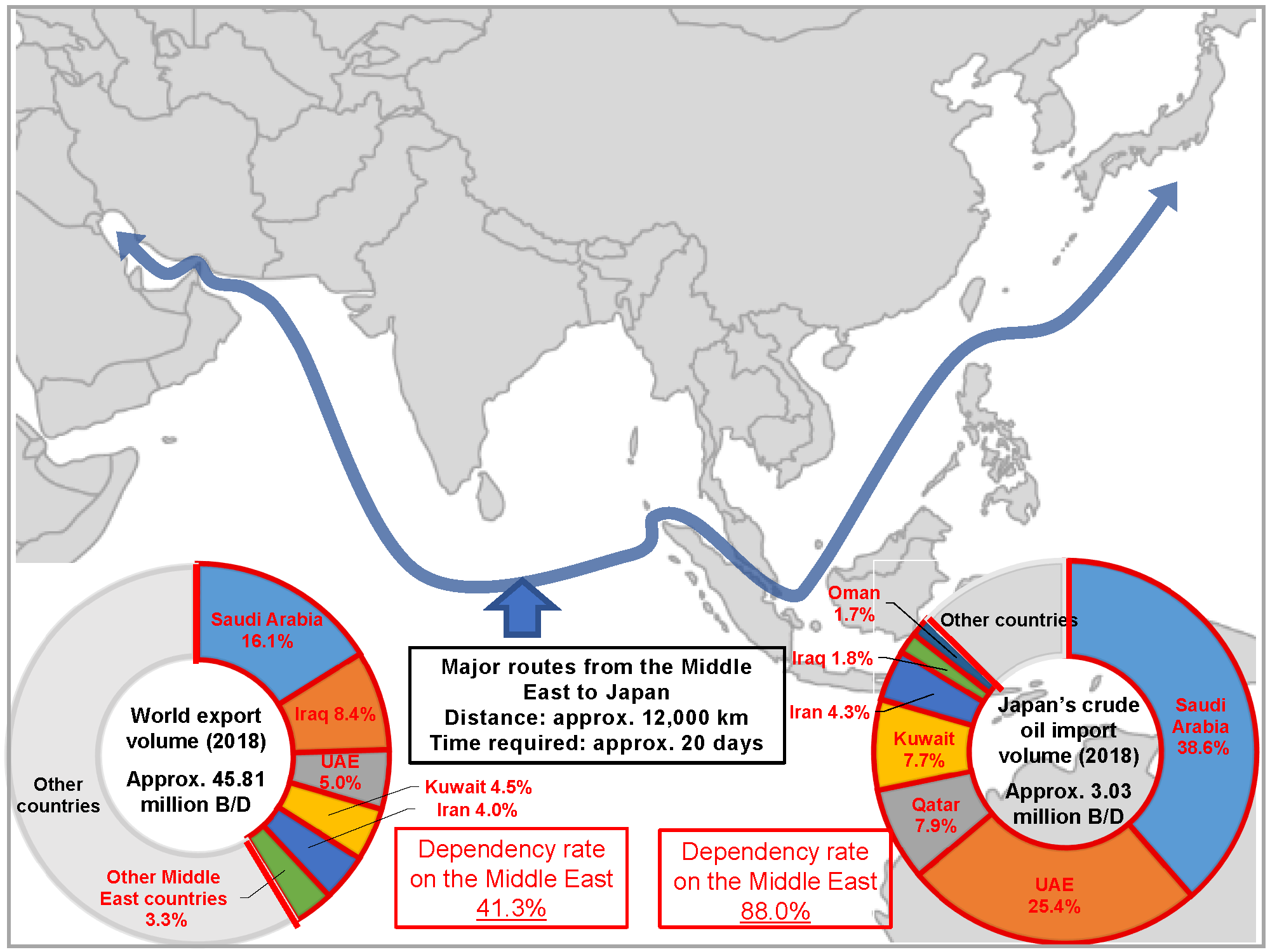
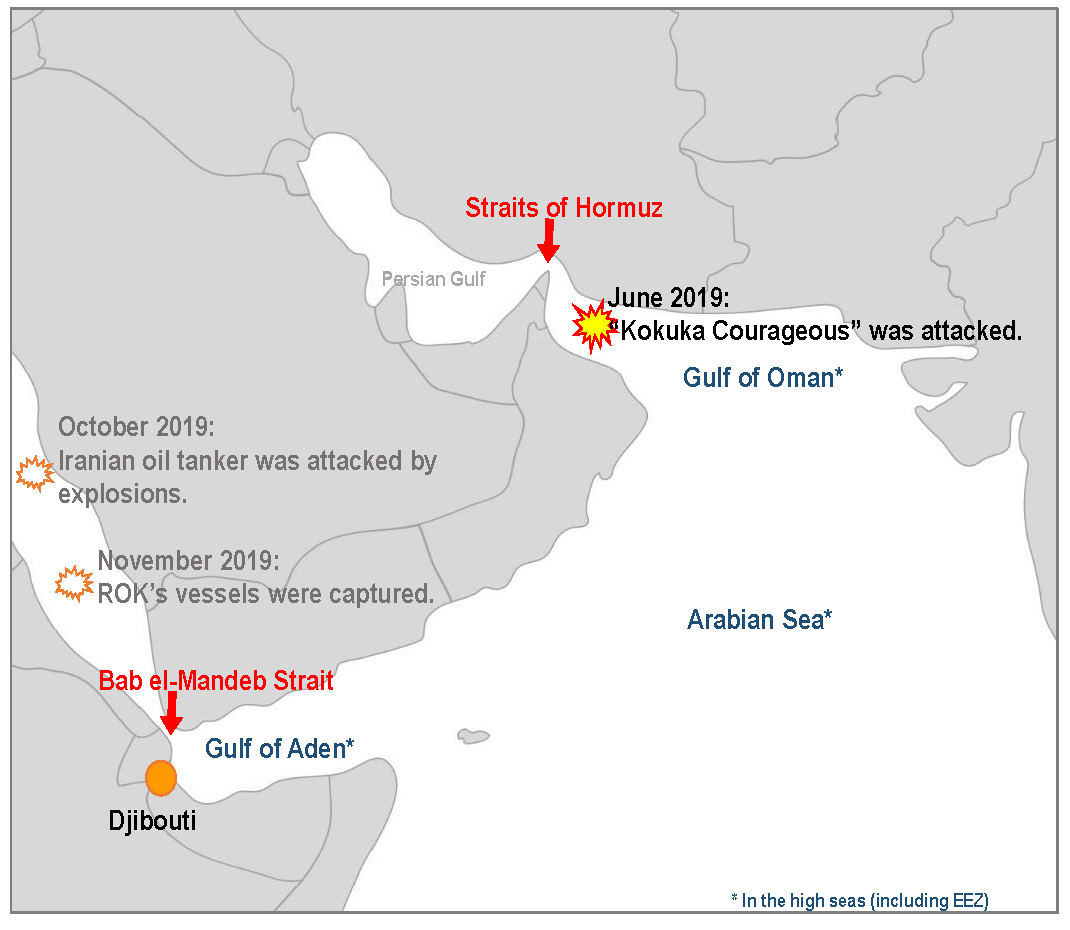
Q2: What kind of information gathering activities does the SDF conduct?
A: The SDF’s information gathering activities are part of the government’s navigation safety measures and are aimed at collecting information necessary to ensure the safety of Japan-related vessels. The activities would need smooth decision making and order issuance in relation to Maritime Security Operations as measures for unforeseen circumstances or other changes in the situation. Specifically, the SDF uses a newly dispatched naval vessel and the aircraft that have been deployed for counter piracy enforcement to monitor the type of ship, ship’s registry, location, course, speed, etc., of ships sailing in the area of activity. Through this, the SDF gathers information that directly affects or is necessary for ensuring safe navigation of vessels, such as the presence of suspicious ships and other signs of unforeseen events.
Q3: What is the geographic scope of the SDF’s information gathering activities? Are the Strait of Hormuz and the Persian Gulf included?
A: The geographical scope of the information gathering activities by the SDF consists of three waters of high seas: the Gulf of Oman, the northern Arabian Sea, and the Gulf of Aden to the east of the Bab el-Mandeb Strait (including the exclusive economic zones of the coastal states). The SDF will not conduct activities in the Strait of Hormuz or the Persian Gulf.
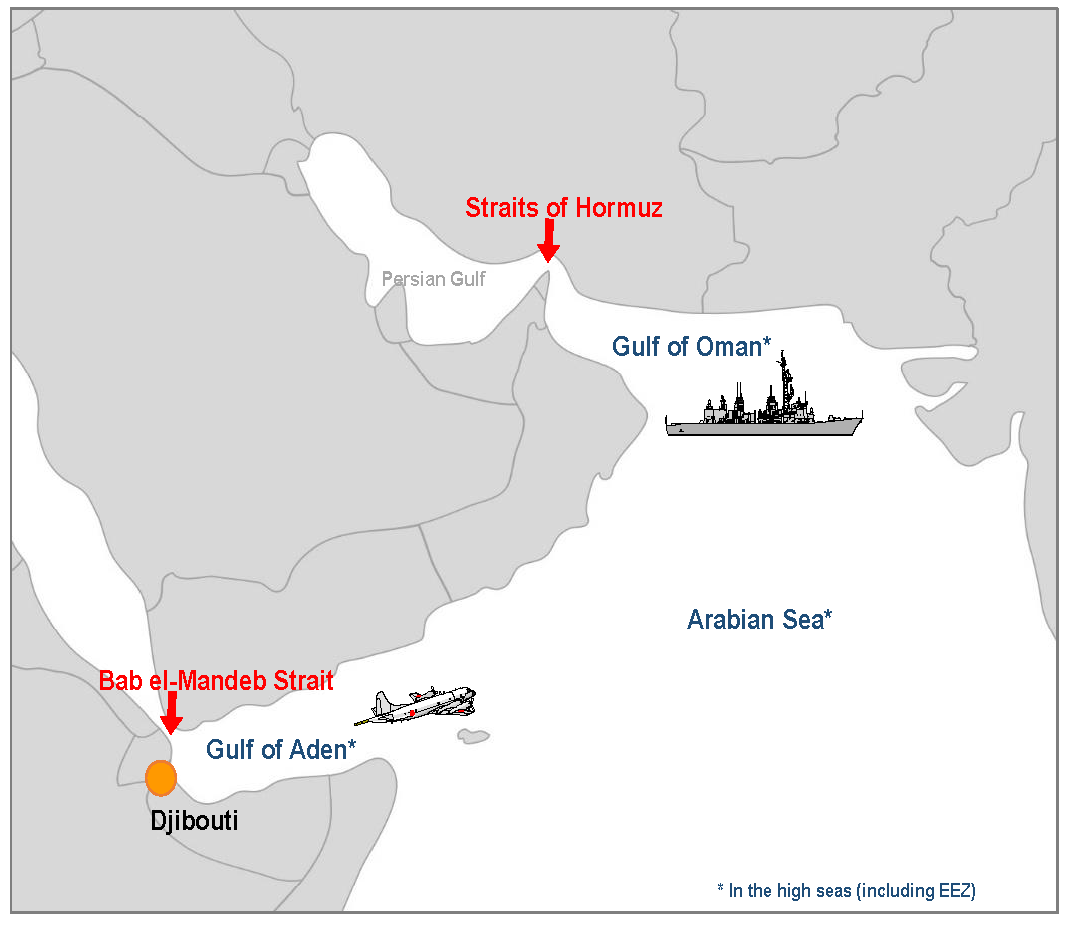
Q4: Why not include the Strait of Hormuz and the Persian Gulf, which are navigated by large numbers of ships?
A: Japan has built good relations with countries involved in the stability of the Middle East, such as maintaining good relations with Iran for many years while being an ally of the United States. Taking advantage of these relations, Japan will make further diplomatic efforts to ease tensions and stabilize the situation in the Middle East. Thorough navigation safety measures and the SDF’s information gathering activities must also be undertaken in harmony with diplomatic efforts.
In addition, it is difficult for any country to cover a vast sea area only with its own assets. The SDF’s information gathering activities should be conducted efficiently, taking into account the volume of vessel traffic and the status of initiatives by other related countries. With these principles in mind, the government examined what an appropriate scope for the SDF’s information gathering activities would be, and it has decided not to include the Strait of Hormuz or the Persian Gulf for the following reasons: [a] in the sea area from the Strait of Hormuz to the Persian Gulf, the navigation of Japan-related vessels is concentrated in the traffic lanes in the territorial waters of the coastal states including Iran and Oman, and as a general rule, ensuring the safe navigation of vessels in these waters is mainly the responsibility of the coastal states that have sovereignty over them; [b] the coastal states may claim that information gathering activities in their territorial waters do not constitute innocent passage; and [c] a certain amount of information on the Strait of Hormuz and the Persian Gulf is expected to be obtained through cooperation with the United States, the coastal states, and other countries.
Q5: The SDF’s information gathering activities are conducted as Japan’s independent initiative. Why does the SDF not take part in the U.S. Forces-led initiative?
A: As a result of a comprehensive review of what measures Japan should take to ensure the safe navigation of Japan-related vessels in the Middle East, Japan has started to implement efforts as Japan’s independent initiative without participating in the International Maritime Security Construct (IMSC) led by the United States, considering the need for ensuring a stable supply of crude oil, relations with the United States, and relations with Iran.
At the same time, to ensure safe navigation in the Middle East, the SDF has been cooperating closely with the United States in various ways. In the information gathering activities, the SDF will also appropriately cooperate with the United States as an ally, including information sharing, while observing the government’s policy of conducting navigation safety measures independently from any other country’s initiatives.
* The United Kingdom, Australia, Bahrain, Saudi Arabia, the UAE, and Albania, and Lithuania, in addition to the United States, participate in the IMSC (as of December February 2020).
Q6: How exactly does the SDF share information with the U.S. Forces?
A: Information sharing with the U.S. Forces is primarily conducted through the liaison officer dispatched to the U.S. Central Naval Command in Bahrain.
Q7: If the SDF shares information with the U.S. Forces, isn’t the SDF in effect participating in the U.S.-led initiative?
A: Japan determines information necessary to ensure the safety of Japan-related vessels according to its own needs, and it uses its own judgment in conducting information gathering activities in areas that it deems appropriate. These activities of the SDF are not subject to the command or control of other countries, including the United States, nor are they conducted according to the needs of those countries. Therefore, even if the SDF shares information with the U.S. Forces, it does not mean that it is in effect participating in the IMSC.
Q8: What are the reactions of the U.S. and Iran to Japan’s policy of deploying the SDF to the Middle East?
A: Japan has gained the U.S.’ understanding by explaining on various occasions its policy of conducting an independent initiative instead of participating in the U.S.-led IMSC. U.S. Secretary of Defense Esper expressed his gratitude to Defense Minister Kono for his explanation on the policy at the Japan-U.S. Defense Ministers' Meeting in January 2020.
At the Japan-Iran Summit Meeting on December 20, 2019, Prime Minister Abe gave a detailed explanation of Japan’s efforts. In response, President Rouhani said that Iran appreciates Japan’s diplomatic efforts to reduce tensions in the region, understands Japan’s intention to contribute to the safety of navigation through its own initiative, and also appreciates that Japan is explaining its efforts to Iran in a transparent manner. Iran maintained the same stance as this also at the Japan-Iran foreign ministers’ meeting held on February 15, 2020.
Q9: Isn’t there a possibility that the deployment of the SDF to the Middle East amid the rising tensions will increase the risk of Japan-related vessels being exposed to danger?
A: Japan maintains good bilateral relations with the Middle Eastern countries . Japan intends to make utmost diplomatic efforts at all levels to maintain and further strengthen these bilateral relations and contribute to the easing of the current tensions and stabilization of the regional situation, while maintaining an up-to-date awareness on developments in the region.
The government has made sure to maintain good communication with these countries, as it is important to gain their understanding of the SDF’s activities. Specifically, in December 2019, then Prime Minister Abe directly explained the intentions of the SDF’s activities to President Rouhani of Iran, who visited Japan, and gained his understanding. Also, during his visit to the Middle East in January 2020, then Prime Minister Abe also provided the same explanations to the leaders of Saudi Arabia, the UAE, and Oman, and gained their support.
Japan will continue its persistent diplomatic efforts to ease tensions and stabilize the situation in the region, while implementing thorough navigation safety measures and cooperating with related countries.
Q10: What is the size of the SDF units deployed to the Middle East?
- A Deployment Surface Force destroyer has been newly deployed for the information gathering activities. In addition, these activities will also be added to the missions of the two P-3C fixed-wing patrol aircraft of the air force unit that has already been deployed in Djibouti for counter piracy enforcement. The newly dispatched destroyer carries about 200 personnel, and the Deployment Air Force for Counter Piracy Enforcement (DAPE), whose aircraft are to be used for the activities, consists of about 60 personnel.
Q11. When did the information gathering activities by the SDF begin?
- Two MSDF P-3C left Japan on January 11, 2020, and began information gathering activities on the 20th. JS “Takanami” left Yokosuka on February 2 and started to engage in information gathering activities on February 26.
Q12. How long will the dispatch to the Middle East last?
The period during which the SDF should engage in the information gathering activities by its destroyer and aircraft is for one year from December 27, 2019, when the Cabinet decision was made. If it is deemed necessary to extend the SDF’s activities, another Cabinet decision or any changes to it will be made in that regard.
On December 11 2020, the Cabinet decision was revised to extend the duration of the activities for a year until December 2021.
At the same time, the SDF may terminate its activities without waiting for the end of the one-year period from the date of the Cabinet decision if the government determines that there is no longer any particular concerns about the safety of navigation of Japan-related vessels and thus there is no longer a need to conduct information gathering activities by the SDF destroyer and aircraft.
In any case, the government will judge the termination of the dispatch by considering the situation in a comprehensive manner.
Q13. Does the government provide any support to the personnel’s families during their deployment?
- To ensure that the deployed personnel can carry out their missions with peace of mind, it is extremely important to gain the understanding of their family members and provide them with meticulous support during the deployment. The government provides the families with a thorough explanation of the great significance of the mission, which is to ensure peace and stability in the Middle East and the safety of navigation of Japan-related vessels, while also offering various support services to ensure that they do not experience any anxiety or inconvenience in their everyday lives during the deployment.
Q14. What are the treatment and benefits for the SDF personnel dispatched to the Middle East?
- The government has prepared various treatment and benefit programs for the personnel dispatched to the Middle East considering his/her experience overseas, in order to ensure that they can focus on their mission with a sense of security. Specifically, a new maritime security allowance will be provided to these personnel, in addition to existing allowances, such as crew, aviation, and navigation allowances. Moreover, should something grave happen to the dispatched personnel, they will be compensated through the accident compensation and gratuity programs. The scope of the PKO insurance for personnel engaging in overseas missions has also been expanded to include the personnel deployed for this mission.
Q15. More SDF personnel are now deployed in the Middle East. Doesn’t it affect the defense of Japan?
A. It is obvious that the implementation of information gathering activities in the Middle East should not affect much-needed warning and surveillance activities and ballistic missile countermeasures in the vicinity of Japan. The government has taken measures to ensure that the dispatch of the destroyer will not affect the SDF’s warning and surveillance activities or other missions around Japan.

